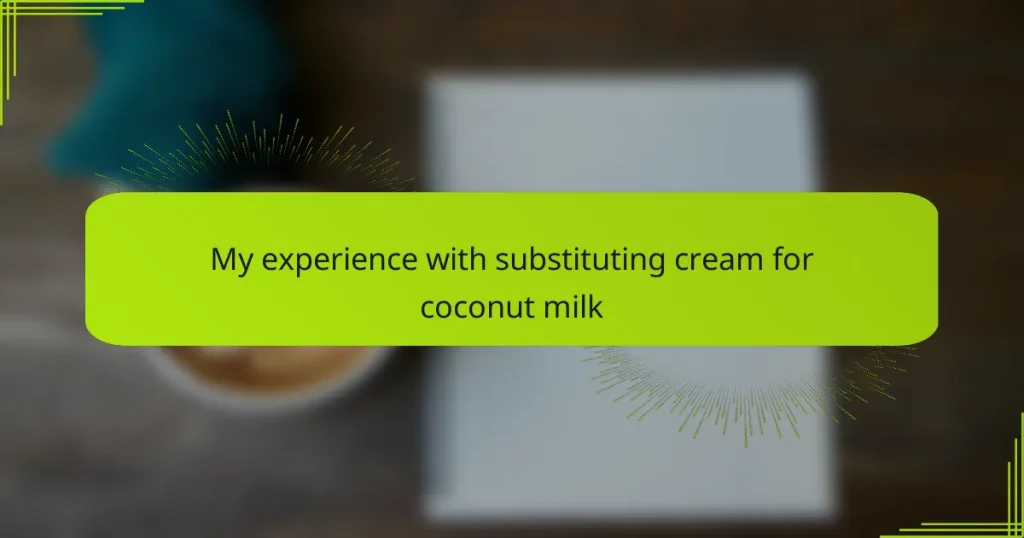Key takeaways
- Cream adds a rich texture and stabilizes desserts, enhancing overall harmony in flavors.
- Coconut milk serves as a dairy-free alternative, imparting a unique flavor and moisture to baked goods.
- Substituting cream with coconut milk requires careful consideration of fat content and flavor adjustments for best results.
- Popular desserts using coconut milk include mango pudding and panna cotta, showcasing its ability to elevate classic recipes.

Understanding cream in desserts
Cream plays a crucial role in many desserts, lending them a silky texture and rich flavor that feels indulgent with every bite. From my experience, its ability to thicken and add that luxurious mouthfeel truly transforms simple ingredients into something special. Have you ever wondered why so many recipes call for cream—it’s not just for taste, but also for the way it interacts with sugar and heat to create that perfect consistency.
I remember the first time I whipped cream for a dessert; the way it turned from liquid to fluffy cloud was almost magical. That lightness balances the heaviness of other components, making the dessert more enjoyable rather than overwhelming. It made me realize how essential cream is in achieving that harmony of flavors and textures.
What’s fascinating to me is how cream acts as a stabilizer in desserts—it helps hold everything together, whether in custards, mousses, or ganaches. This functional quality is something I truly appreciate after a few baking mishaps where skipping or substituting cream didn’t quite deliver the same result. It’s that subtle but vital ingredient that turns a good dessert into a memorable one.

Overview of coconut milk in baking
Coconut milk has become one of my go-to ingredients when I want to add a tropical twist or dairy-free option in baking. Its natural creaminess and subtle sweetness bring a unique depth that you don’t always get from traditional dairy cream. Have you ever noticed how it imparts a slightly nutty flavor that can elevate simple cakes or puddings?
I’ve found that coconut milk behaves differently under heat compared to cream. It doesn’t whip up into light peaks, but it blends smoothly, adding moisture and a soft richness that’s perfect for denser baked goods. This makes me appreciate its particular role—not as a direct replacement in every situation, but as a complementary alternative depending on the texture and flavor you want.
What surprised me early on was how coconut milk’s fat content varies depending on the brand or whether it’s canned or carton. This can affect the outcome more than you might think, especially in delicate recipes. I learned that understanding this helps me decide when it’s worth substituting cream with coconut milk, and when to stick with the original ingredient for the best results.

Reasons for substituting cream
Sometimes, I choose to substitute cream because of dietary reasons—whether I’m cooking for someone who is lactose intolerant or simply trying to reduce dairy in my meals. Have you ever had to adjust a recipe on the fly because a guest couldn’t have cream? That’s often been my motivation to explore alternatives like coconut milk.
There are also moments when I crave a lighter dessert, and cream’s richness feels a bit too heavy. In those cases, swapping in coconut milk gives the dish a gentler texture without sacrificing moisture. It’s interesting how a simple ingredient swap can change the whole eating experience.
Occasionally, availability plays a role. I recall one weekend when I ran out of cream, but I had a can of coconut milk tucked away—it saved the day and sparked my journey into experimenting with substitutes. Those unexpected moments sometimes lead to the most rewarding kitchen discoveries.

How to substitute cream with coconut milk
When I first tried substituting cream with coconut milk, I realized it’s not always a one-to-one swap. Coconut milk’s consistency can be thinner, so I often reduce it gently on the stove to thicken it before adding it to my dessert. Have you ever noticed how simmering coconut milk helps mimic that creamy texture you get from dairy?
One trick I’ve learned is to use full-fat coconut milk, especially the canned variety, since it has more richness and less water. It makes a big difference in achieving that luscious mouthfeel cream usually provides. I like to chill the can overnight and scoop out the thick cream on top, which feels almost like nature’s own version of heavy cream.
You might wonder if coconut milk affects the flavor too much. From my experience, the subtle coconut note can actually enhance many desserts, especially those with tropical or fruity elements. But if you want a neutral taste, blending coconut milk with a little vanilla or almond extract has saved many recipes of mine from tasting too “coco-nutty.”

Effects on dessert texture and flavor
The first time I swapped cream with coconut milk in a mousse, I noticed the texture was softer and less velvety than usual. It lacked that dense, silky feel cream usually lends, but instead brought a gentle creaminess that felt lighter on the palate. Have you ever had a dessert where the mouthfeel changed so much it surprised you? That was my aha moment—coconut milk creates a more delicate texture rather than an indulgent one.
Flavor-wise, the subtle coconut essence definitely makes its mark. At first, I wondered if it would overpower the dessert, but often it added an unexpected warm, nutty background that complemented fruity or spiced notes beautifully. I found that in lemon tarts or mango puddings, this touch of coconut enhanced the overall flavor instead of competing with it. Still, I’ve learned it’s a flavor shift worth considering before making the swap.
On occasion, I’ve also noticed coconut milk can make desserts feel a bit wetter or less stable, especially in recipes relying on cream’s thickening power. This sometimes called for compensating by adjusting other ingredients or chilling the dessert longer. It taught me that texture and flavor are delicately intertwined, and changing one affects the other more than I initially expected. Have you ever had to tweak a recipe just to get the texture back on track? That’s part of the fun—and challenge—of experimenting with substitutions.

Tips from personal substitution experience
One tip I can’t stress enough is to experiment with the fat content in coconut milk before substituting it for cream. I once used a light coconut milk straight from the carton and ended up with a dessert that felt flat and watery. Have you ever been surprised by how such a small detail can change the entire outcome? Since then, I always choose full-fat canned coconut milk and sometimes reduce it to get that rich, creamy texture closer to what cream offers.
Another lesson I learned the hard way is to factor in flavor adjustments. At first, I ignored how coconut milk’s subtle coconut flavor might interact with the other ingredients. But after a few tries, adding a touch of vanilla or almond extract helped balance the tropical notes without overpowering the dessert. It’s a simple trick that gave me much more control and confidence in creating the perfect taste.
Lastly, patience pays off when using coconut milk as a substitute. I recall one batch of mousse that just didn’t set right until I chilled it longer than usual. It taught me that desserts using coconut milk might require extra time in the fridge to firm up properly. Have you noticed how waiting a bit longer can make all the difference? This is one small adjustment that improved my results significantly.

Best dessert recipes using coconut milk
When I think about the best desserts that showcase coconut milk, creamy mango pudding instantly comes to mind. The coconut milk adds such a gentle sweetness and smoothness, turning simple mango puree into a luscious treat that feels both tropical and comforting. Have you tried it? The way the coconut flavor subtly dances with the fruit enhances the dessert without overpowering it.
Another favorite of mine is coconut milk panna cotta. Unlike the traditional version made with cream, this one offers a delicate, silky texture that feels lighter but still indulgent. It’s fascinating how coconut milk can bring a softness to the panna cotta that makes each spoonful feel refreshing rather than heavy—a perfect balance I didn’t expect at first.
I’ve also had great success with coconut milk in chocolate pot de crème. The richness of dark chocolate combined with the creamy, slightly nutty background from the coconut milk creates a depth of flavor that just hooks me every time. It made me realize that coconut milk isn’t just a substitute—it’s an ingredient that can elevate classic desserts in its own unique way. Have you ever had a dessert surprise you like that?




